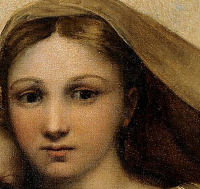Raphael: the Mozart of art?
Raphael and Mozart – the best, or the most average?
In writing the title, I feel as though I shall soon be hauled in front of the inquisition. Here then is my defense.
It is a natural tendency to take general assertions as gospel truths. Why do you vote for a particular party? Why do you attend a particular church? For many, the answer is ‘Because I always have.’ That may sound damning; but it is not. To have ‘always done’ something is not necessarily bad; on the contrary, repetition of an act is fundamental to our lives. I drink two cups of coffee every morning, I check the weather predictions before work, I pick up my knife in my right hand and my fork in my left. Life is hugely repetitive.
There is an extension to this fact, an induction if you will, that is relevant to the Arts. General assertions commonly govern what we think we should think about Art. Do you think Picasso is the greatest painter of the 20th century? Do you think Dickens is the greatest (English language) writer of the 19th? Do you think Bach is the greatest composer of the 18th? Do you think Bernini is the greatest sculptor of the 17th?
I shall not give my answers to those questions! Another time, perhaps. But instead I shall cite a single example in one domain. Leonardo da Vinci’s La Gioconda is not the greatest portrait ever painted. Its fame comes from the fact that it was (fortuitously) the property of a French king, and it was stolen and lost for a couple of years. That famous smile is not enigmatic – it was created with a technique, well-known at the time, that creates an image, ill-defined enough to be open to almost any interpretation. Maybe her husband has just said that he would make supper? She knows what a catastrophe that could be, but she does not want to show her thoughts…
I shall show you a much better portrait. You will disagree – you will even tell me that Rembrandt captured the human condition so much better. But Raphael Sanzio da Urbino created one of the most perfect facial images, an image where enigma and condition have no relevance: this is perfection in art.

Before extrapolating from that thesis, I want to turn my attention to Mozart.
Wolfgang Amadeus Mozart showed, from the youngest age, an extraordinary facility both in the performance of music and in its composition. He could give concerts on the fortepiano from the age of six; he composed his first opera at age eleven. One of his most famous pieces is the so-called Eine Kleine Nachtmusik:
Written when Mozart was 31, it was not published until some forty years after his death, but soon became one of his most popular works. It was composed at the height of what became known as the ‘classical’ period of music, and exemplifies that style: clear melodic lines, fundamental harmonies based on acoustic principals, balanced orchestration. His works are usually cited as the embodiment of perfection in music.
Perfection is a strange thing. It is generally considered an ultimate goal, something we should all strive for, and as such Raphael and Mozart represent the pinnacle of their Art. But perfection is an artistic cul-de-sac. You have reached the top of the mountain; where do you go from there? There is only one solution: break the mold. Beethoven (fifteen years younger than Mozart) did this, and brilliantly showed what imperfect music would sound like:
Beethoven: Grosse Fuge, op.133
Beethoven was a surpassing genius in music, and he created a whole new world of sound. What of other composers, less gifted than him? For many, the answer was to follow Mozart, to take the characteristics of his music and apply them to their own creations. The result was a wealth of music that has the outward structure of his composition, but lacks the spark of his genius. This becomes a kind of norm, an average that everyone could use.
This is the case with Raphael also: you cannot surpass perfection, and so if you equal his achievement, you are doing no more than copying him. To do that successfully you would need his genius! His impact on the world of art was therefore to create a norm on which others could build.
So – was their Art average? It showed a typical, or common, framework which was a yardstick for others to build on. That became the average structure; but what they themselves built on the structure was genius; it was perfection.
* * *
Afterthought
With some exceptions, I do not like the music of Mozart. I am human; while I might enjoy perfection in the next life, my current one is imbued with the imperfections of human existence. I love those ‘imperfections’ in the music of Beethoven, and I am fascinated by the music of our era:
Boulez: Le marteau sans maître
You may wonder what I can see in that ‘music’ that rivets my attention. So perhaps that should be the topic of my next blog on music…